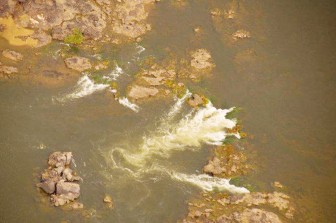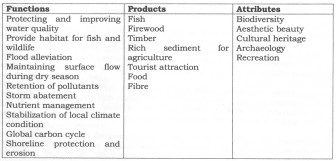Wetlands are areas that hold water, either seasonally or permanently; they have been titled the kidneys of the landscape and biological supermarket because of the functions they perform in the hydrological and chemical cycles and the extensive food web and rich biodiversity they support. Examples of a wetland include ponds, lakes, rivers, swamps, creeks and seasonally flooded ponds and savannah areas.
The international convention that looks at the management and conservation of wetlands is Ramsar; this convention encourages its signatory countries to identify and designate suitable sites as Wetland Sites of International Importance. One such area for Guyana could be the Iwokrama Forest and North Rupununi Wetlands.
In central Guyana the Iwokrama Forest and the North Rupununi Savannah combine to form a unique wetland system that when flooded brings new life to the region. During the rainy season there is the meeting of the white water Rupununi River and the black water Essequibo River as these rivers overflow their banks. The flooded area creates a major spawning ground for fish. During this period many other animals depending on the season of plenty also breed. One of the interesting phenomena noted in the Rupununi Wetlands as the rainy season approaches is the “march” or migration of fish up the rivers as they prepare to spawn. The Makushi will tell you that the fish come in waves. The first wave will include such species as the Baiara, Yakatu, Houri, Cartabac, Pacu, Perai and Dawalau. The second wave would include such species as the Cullits, Skeet, Zip Fish and Lao Lao. During the period people use the opportunity to stock up on fish as once the fish begin to move out into the flooded lands it becomes very difficult to capture them.

The rainy season and flooding lasts for over 5 months. This can be extended if La Niña periods and the fish spread out into the flooded forest and savannah to lay their eggs and feed. Many of the species such as the Arapaima that breed in the ponds would follow these fish, doing what is called a lateral migration. As the water recedes the fish go with it; many are trapped in the ponds, lakes and shallow pools within the savannah and forest as the water finally dries off the land. This replenishment will provide a ready protein source for community members over the next year until the next rainy season. Those fish trapped in the shallow pools or ponds become prey for humans, birds and other animals.
As the dry season progresses and ponds dry and shrink, many of the birds and animals that came to hunt and fish will return whence they came; others will move back to the rivers, lakes and ponds. Seven months later the cycle will begin again.
Wetlands provide not only a habitat for plants and animals like the water birds, fish, mammals and herptofauna; they also provide a wide range of important goods and services to man. These goods and services can be classified into three groups – functions, products and attributes.
Rain forests are rich in biodiversity and are home to many different plants and animals. In addition, indigenous communities make their homes there. Even if you don’t live in the rain forest, humans rely on the forest for resources such as building materials (wood and lianas), medicine and fruits. Rain forests also provide essential environmental services for life on earth; they create soil as well as prevent soil erosion, produce oxygen though photosynthesis, maintain clean water systems, and are a key defence against climate change.
The Iwokrama Rain Forest is 371,000 hectares, located in the heart of Guyana. Our mission is to develop strategies for conservation and sustainable development for local people in Guyana and the world at large. We are involved in tourism, training, research and our timber is certified by the Forest Stewardship Council. Come and visit us in the rain forest or at http://www.iwokrama.org.






